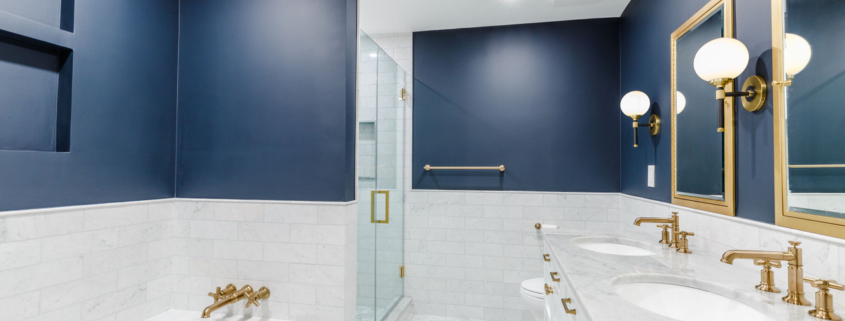What Is the Difference Between an Interior Designer and a Contractor?
When planning a home or commercial renovation, one of the most common questions property owners ask is: What is the difference between an interior designer and a contractor? While both play essential roles in transforming spaces, their responsibilities, expertise, and involvement in a project differ significantly.
Understanding these distinctions can help you choose the right professional for your needs, ensuring a smooth and successful renovation.
Interior Design vs. Contracting: Defining the Roles
An interior designer focuses on aesthetics, functionality, and space planning. They bring creative vision to a project, selecting color palettes, furniture, materials, and décor to create a cohesive and visually appealing environment. Interior designers also consider ergonomic and psychological aspects of design, ensuring a space is both beautiful and practical.
An interior contractor, on the other hand, handles the physical execution of a renovation or remodel. They are responsible for construction work, structural modifications, electrical and plumbing installations, and ensuring that the design is implemented correctly.
Contractors work closely with architects, designers, and clients to bring design concepts to life while adhering to safety codes and regulations.
Key Differences Between an Interior Designer and a Contractor
Below, we’ll look at the differences between an interior designer and an interior contractor:
Scope of Work
Interior designers focus on conceptualizing and refining a space’s aesthetic appeal. Their expertise includes:
- Space planning and layout optimization
- Color coordination and lighting schemes
- Selecting furniture, finishes, and accessories
- Incorporating sustainable and ergonomic design elements
- Ensuring design coherence across all aspects of a space
Contractors, in contrast, handle the physical execution of a project. Their responsibilities involve:
- Structural modifications and renovations
- Installing flooring, cabinetry, and fixtures
- Managing electrical and plumbing work
- Complying with building codes and permits
- Overseeing construction teams and subcontractors
Education and Training
Interior designers typically hold degrees in interior design, architecture, or related fields. Many obtain certifications from professional organizations, such as the American Society of Interior Designers (ASID) or the National Council for Interior Design Qualification (NCIDQ).
Contractors, on the other hand, must have hands-on construction experience and may need licenses depending on the state or region. They are knowledgeable in building materials, safety regulations, and construction techniques, ensuring a project is built to last.
Project Involvement
A key distinction in interior design vs. contracting is when each professional becomes involved in a project. Interior designers are typically engaged at the early stages of a renovation, helping to develop design concepts and detailed plans. They work closely with clients to understand their vision and needs before passing their plans to a contractor.
Contractors step in once the design is finalized and construction begins. They ensure that the work follows the agreed-upon plan and meets all structural and safety requirements. Contractors coordinate the labor, materials, and schedules to complete the project efficiently.
Creativity vs. Technical Execution
Interior designers bring a creative approach to a project, focusing on aesthetics, mood, and usability. They stay updated on design trends, materials, and innovations, helping clients achieve a customized and stylish space.
Contractors prioritize technical execution, ensuring that walls are properly constructed, plumbing is correctly installed, and electrical wiring meets code. Their role is more hands-on, requiring problem-solving skills and construction expertise.
When to Hire an Interior Designer vs. a Contractor
Deciding whether to hire an interior designer or an interior contractor depends on the scope of your project.
Hire an Interior Designer
You need help with the creative vision, space planning, and selecting finishes, furnishings, and materials. Designers excel at transforming spaces into functional, aesthetically pleasing environments.
Hire an Interior Contractor
You require structural changes, installation work, or renovations that involve walls, plumbing, electrical, or flooring. Contractors bring the design to life through skilled construction work.
Hire Both
You’re undertaking a full-scale remodel or renovation where both design expertise and construction are required. Designers and contractors often collaborate to ensure the seamless execution of a project.
How Interior Designers and Contractors Work Together
While their roles differ, interior designers and contractors frequently collaborate on projects. A designer may develop a detailed renovation plan, including 3D renderings and material selections, and then pass the project to a contractor to execute.
Contractors rely on these design specifications to guide their work, ensuring that every detail aligns with the designer’s vision. Regular communication between both professionals helps address any unexpected challenges during construction, ensuring a smooth process and a high-quality result.
Cost Differences: Interior Designers vs. Contractors
The cost of hiring an interior designer vs. a contractor varies based on project complexity, location, and the professional’s experience.
- Interior designers typically charge either a flat fee, hourly rate, or a percentage of the total project cost. Their fees can range from $50 to $200 per hour or more for high-end designers (HomeAdvisor).
- Contractors charge based on labor, materials, and the complexity of the construction work. Their costs can vary widely but often start at $50 to $150 per square foot for major renovations.
For large-scale renovations, hiring both a designer and contractor ensures a well-planned and professionally executed project.
Choosing the Right Professional for Your Renovation
When considering interior design vs. contracting, assess your project’s needs, budget, and goals. If your focus is on aesthetics, layout, and styling, an interior designer is the right choice. If structural work, installations, or construction modifications are required, an interior contractor is necessary.
For the best results, working with both professionals ensures that your vision is fully realized while meeting safety and building standards.
Transform Your Space with Nest Inc.
At Nest Inc., we provide expert interior contracting services tailored to your renovation needs. Whether you require full-scale remodeling, custom finishes, or seamless integration of design and construction, our team ensures top-tier results.
Ready to bring your project to life? Schedule a Consultation Today, and let’s create a space that combines beauty, functionality, and expert craftsmanship.









